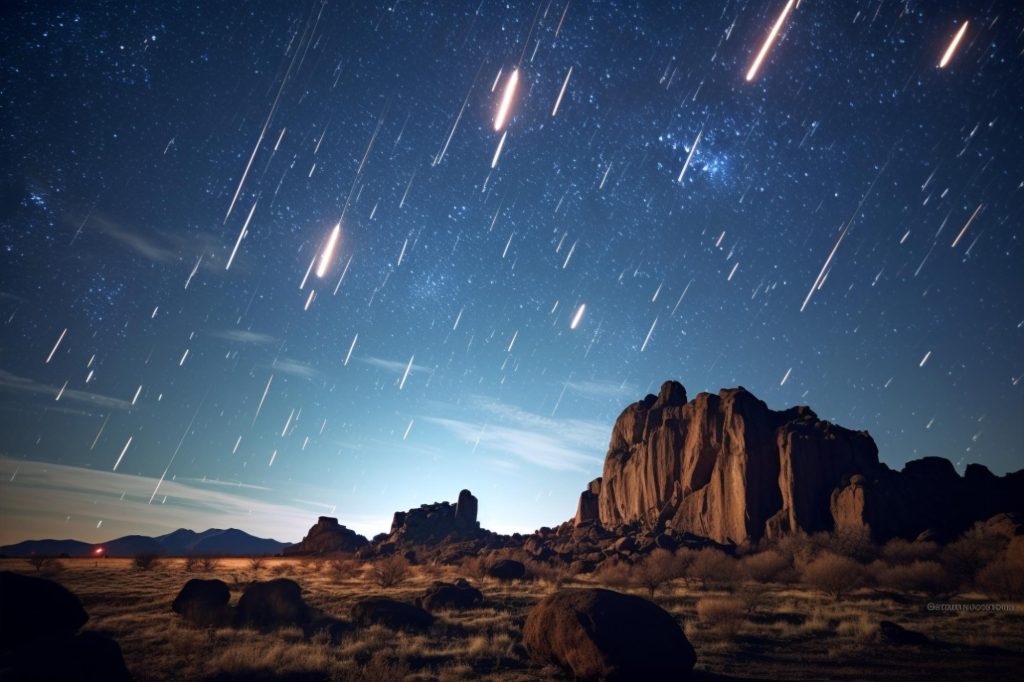The 2024 Perseid meteor shower will peak on August 11 and 12, and will be best viewed after the moon has set, away from city lights. Prepare for chilly temperatures, bring the essentials for a local viewing event, and enjoy a nice, comfortable evening under the meteors. (Artist’s rendering) Credit: SciTechDaily.com
The 2024 Perseid meteor shower will reach its peak on the night of August 11 and will be a spectacular sight, although the waxing Moon may slightly obstruct visibility.
The ideal viewing conditions are dark, clear skies away from city lights. To enjoy the meteor shower best, join a local observing party, stay warm, and be patient. National Aeronautics and Space Administration (NASA) Other astronomy sites offer tips and tools for tracking the peak of the meteor shower.
2024 Perseid meteor shower
Are you prepared for the 2024 Perseid meteor shower? The Perseid meteor shower is expected to peak on the night of August 11 into the morning of the 12th, with good visibility on the nights before and after. You may have already seen a few of the Perseids streaking across the summer sky.
This meteor shower is part of a stream of cometary debris. Swift TuttleThe Perseid meteor shower actually begins in mid-to-late July and continues through most of August. Most of these nights will only see a few meteors per hour, but during the peak of the Perseid meteor shower, many more will be visible. How many more? The number varies from year to year. Sometimes there will only be a few dozen per hour, but in rare years there will be a short “burst” of up to 200 beautiful “shooting stars” per hour.
Viewing conditions and viewing time
This year’s Perseid meteor shower will be slightly influenced by the 53% waxing crescent moon, but the moon will set by the time the Perseids reach their peak. This means that if you’re in an area with clear skies free of light pollution, you may be able to see quite a few meteors in one night. How many will you be able to see? There’s only one way to find out for yourself how strong this year’s Perseid meteor shower is: get outside and be patient.
Tips to improve your viewing experience
Here are some tips to help you get the most out of your meteor shower viewing experience.
- Get out of town! Try to go to a dark place as much as possible, as the darker it is, the more you’ll be able to see meteor trails crossing the sky.
- Check the weather forecast for that night. You may need to check two or three locations for fog, clouds, and temperature predictions. Some weather forecast sites offer forecasts specifically for sky watching. Make sure you have clear skies, not just dark skies.
- Find a meteor shower party! Attend a meet-up with like-minded people at your local park, or an event hosted by your local astronomy club. Try searching the Night Sky Network to find Perseid meteor shower parties, especially if it’s your first time. Clubs near you,or Find an event near you
- Be prepared to stay warm and comfortable outside! You’ll be outside for a long time, so you’ll want to lie on your back to see the sky as much as possible. To stay warm, bring blankets, jackets, hats, hot drinks, and water. It may seem silly to bring warm clothes in the middle of summer, but late at night the temperature drops and it can get chilly. If you’re in an area with a lot of bugs, it’s a good idea to apply bug spray to avoid bug bites.
- Feel free to bring your friends and family! Spending time under the stars with friends is great, with the added bonus of increasing the number of people watching the sky. If you go with a group, you’re likely to spot more meteors than you would on your own, and you can help each other find “hot spots” in the sky. (Plus, if you’re out in the wilderness in the dark, having good company is comforting.)
Additional Resources and Information
Find out more about our favorite meteor showers here. NASA’s Perseid meteor shower page and EarthSky’s Amazing Observation Guide. Check this out too JPLIn NASA’s August 2023 “What’s Up?” video (embedded above), Preston Dyches offers some great tips on how to observe the Perseids, as well as other objects to look for in the night sky while you wait for these brilliant meteor showers. Meteor shower activity app “Fluximator” Try to predict when peak activity will occur in your area, and we’ll also provide handouts for you to use at stargazing events and outreach events. Be careful! It’s a meteor shower. Resource page.
Have fun, and we hope for clear skies and beautiful weather for your meteor shower party!


